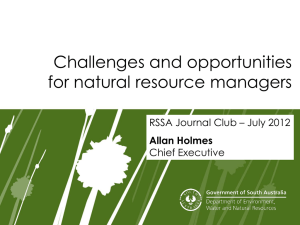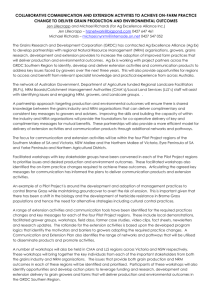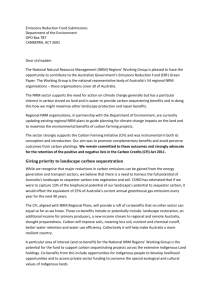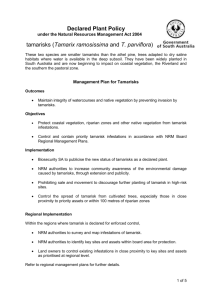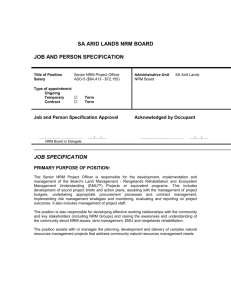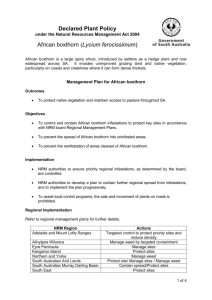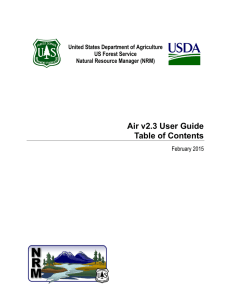Proclaimed Plant Policy
advertisement
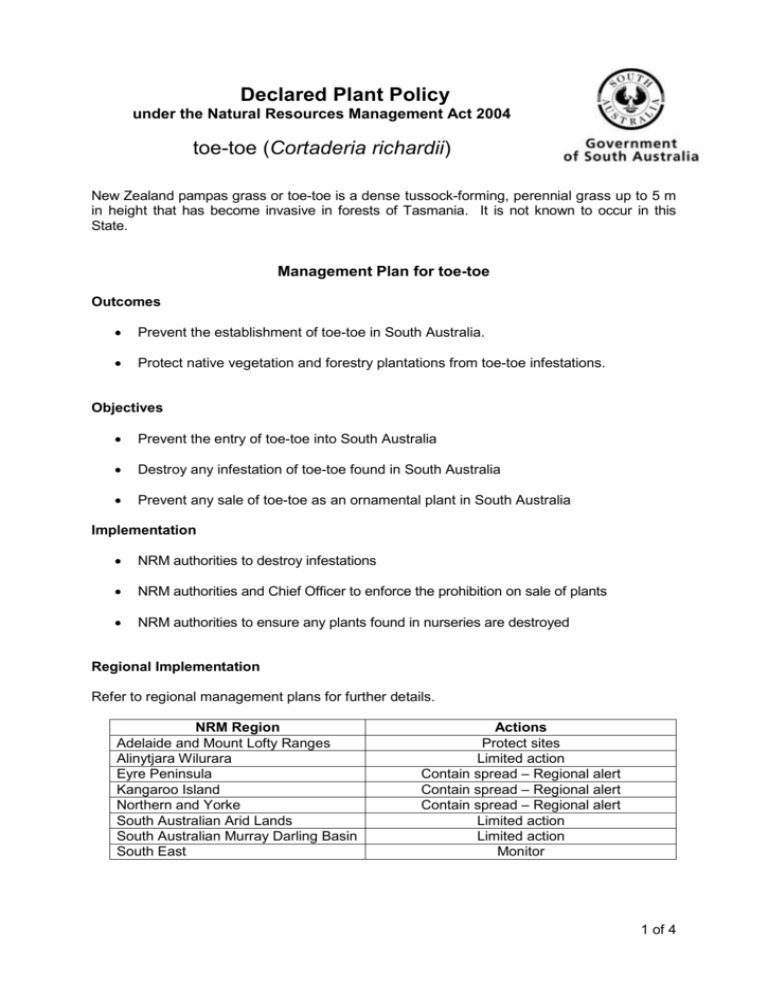
Declared Plant Policy under the Natural Resources Management Act 2004 toe-toe (Cortaderia richardii) New Zealand pampas grass or toe-toe is a dense tussock-forming, perennial grass up to 5 m in height that has become invasive in forests of Tasmania. It is not known to occur in this State. Management Plan for toe-toe Outcomes Prevent the establishment of toe-toe in South Australia. Protect native vegetation and forestry plantations from toe-toe infestations. Objectives Prevent the entry of toe-toe into South Australia Destroy any infestation of toe-toe found in South Australia Prevent any sale of toe-toe as an ornamental plant in South Australia Implementation NRM authorities to destroy infestations NRM authorities and Chief Officer to enforce the prohibition on sale of plants NRM authorities to ensure any plants found in nurseries are destroyed Regional Implementation Refer to regional management plans for further details. NRM Region Adelaide and Mount Lofty Ranges Alinytjara Wilurara Eyre Peninsula Kangaroo Island Northern and Yorke South Australian Arid Lands South Australian Murray Darling Basin South East Actions Protect sites Limited action Contain spread – Regional alert Contain spread – Regional alert Contain spread – Regional alert Limited action Limited action Monitor 1 of 4 toe-toe policy Declaration To implement this policy, toe-toe is declared under the Natural Resources Management Act, 2004 throughout the whole of the State of South Australia so that cultivation, sale and movement of plants can be prevented. The movement or transport of the plant on a public road, by itself or as a contaminant, or the sale by itself or as a contaminant is prohibited. In all regions, land owners are required to destroy any toe-toe plants growing on their land. NRM authorities are required to destroy plants growing on road reserves, and may recover costs from the adjoining land owners. Notification of the presence of plants is necessary to ensure any incursions are promptly detected and destroyed. Toe-toe is declared in category 1 under the Act for the purpose of setting maximum penalties and for other purposes. Any permit to allow its movement or sale can only be issued by the Chief Officer pursuant to section 188. The following sections of the Act apply to toe-toe throughout each of the NRM regions noted below: EP KI NY SAAL SAMDB SE 175(1) Prohibiting entry to area 175(2) Prohibiting movement on public roads 177(1) Prohibiting sale of the plant 177(2) Prohibiting sale of contaminated goods 180 Requiring notification of infestations 182(1) Landowners to destroy the plant on their properties 182(2) Landowners to control the plant on their properties 185 Recovery of control costs on adjoining road reserves AW Sections of Act AMLR Region X X X X X X X X X X X X X X X X X X X X X X X X X X X X X X X X X X X X X X X X X X X X X X X X X X X X X X X X Review This policy is to be reviewed by 2020 or in the event of a change in one or more regional management plans for toe-toe. Weed Risk Invasiveness Toe-toe establishes a large root system up to 3.5m deep and spreads from seed and rhizomes (root segments). It produces large quantities of seed, of the order of 240,000 viable seeds per plant, and may be spread up to 25 km by wind. It is dependant on seed for propagation, and seedling establishment appears to be their most critical life stage. The seeds have no dormancy and are short-lived, probably no longer than one year. Seedlings need reliable moisture in their first year to establish. Toe-toe does particularly well in wetter conditions, making wetlands along rivers and inlets and wet, disturbed heathlands especially vulnerable to infestation. Common sites of infestation are roadsides, road cuttings, quarry faces, sand dunes, mine spoil, new forest plantations and burnt or mechanically disturbed bushland. It can thrive in low-fertility situations and also tolerate waterlogged conditions. 2 of 4 toe-toe policy Impacts Experience with other Cortaderia species has shown that, once established, they are highly competitive, restrict the regeneration of native trees, become a fire hazard and can harbour vermin. They are of greatest potential weed significance to forestry operations, but are not considered agricultural weeds, because young plants are readily grazed by stock and have no potential to establish in cropping systems. Toe-toe is likely to behave in a similar way. In Tasmania it rapidly colonises disturbed or burnt areas in a range of vegetation types from closed forest to coastal scrub, where it outcompetes native plants. It can impede access along roads and walking tracks. Potential distribution Cortaderia species grow on soils ranging from sand to clay and moderately acid to alkaline. They appear to be adapted to growth on low-nutrient soils and are most competitive on these sites. It has a wide potential distribution in the southern part of South Australia including the majority of forested areas of the State, and wetlands or wooded areas in much of the agricultural zone. The pastoral regions are too dry for the establishment of toe-toe. Feasibility of Containment Control costs The method of control for pampas grasses depends on the site on which they occur and the potential risk for causing new infestations. Permanent mechanical removal is recommended wherever possible. Smaller plants (less than 40cm) can be controlled using a wiper applicator with the recommended herbicide. For larger plants, slash the plant to reduce the foliage, taking care to dispose of any plant material in the appropriate way to prevent re-establishment, and then spray with herbicide. Toe-toe is grazed by stock when it is young, before the foliage becomes too abrasive. Grazing prevents the development of flowers and seed set. Plants can also be burnt (if local conditions allow), then allowed to reshoot and the new growth sprayed with herbicide. Persistence Individual toe-toe clumps are long lived, capable of surviving for decades. They are resilient to fire once established and can tolerate extended dry periods. As the seeds survive only a single year in the soil, no significant seed bank is formed. Current distribution Toe-toe is not naturalised in SA and apart from one plant that has now been removed from the Mount Lofty Botanic Garden, it is not known to have been imported to SA but may possibly have been used in other large gardens in the Adelaide Hills. In Tasmania it has become a weed of forest plantations. 3 of 4 toe-toe policy State Level Risk Assessment Assessment using the Biosecurity SA Weed Risk Management System gave the following comparative weed risk and feasibility of containment scores by land use: Land use Forestry Native vegetation Weed Risk 34 35 Feasibility of control 0 0 Response at State Level monitor monitor Considerations Toe-toe is absent from and only small areas are vulnerable to its establishment. Risk assessment indicates monitoring as the management action at State level; this is implemented by destroying infestations as found in the regions where toe-toe can grow. Only limited action is needed in the Alinytjara Wilurara, South Australian Arid Lands and South Australian Murray Darling Basin NRM regions, which do not contain habitats susceptible to invasion. Other regions are monitored for any incursion of toe-toe. The Adelaide and Mount Lofty Ranges region also has planned to protect sites as it contains high rainfall forest habitats susceptible to invasion. Toe-toe is treated as an Alert Species at State level, and regionally in the Eyre Peninsula, Northern and Yorke and Kangaroo Island NRM regions. Synonymy Cortaderia richardii (Endl.)Zotov, New Zealand J. Bot. 1: 84 (1963) Basionym: Arundo richardii Endl., Ann. Wiener Mus. Naturgesch 1: 158 (1836) Taxonomic synonyms: Arundo kakao Steud., Syn. Pl. Glumac. 1: 194 (1854) Gynerium zeelandicum Steud., Syn. Pl. Glumac. 1: 198 (1854) Arundo australis A. Rich. ex Steud., Nomencl. Bot. 1: 143 (1821) Other common names include toi-toi, New Zealand pampas grass, Richard’s pampas grass and South Island toi toi. References Duckett, T. (1989) Managing Tasmania's pampas grass problem: a strategy for control. Tasforests 1: 27-31. Hon Ian Hunter MP Minister for Sustainability, Environment and Conservation Date: 28 July 2014 4 of 4
